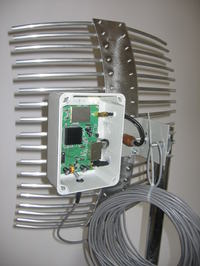Dear Forum Members,
I have already looked through our WiFiforum and unfortunately I have not come across a topic that would explain how "cow peasant in a ditch" the difference between:
1. Repeater,
2. Access Point,
3. Router (with two transmitting and receiving radios)
Unfortunately, I live in the countryside and unfortunately I cannot connect to Neostrada (although my neighbor across the street has Neostrada). Therefore, I am taking advantage of the courtesy of the neighbor who gives me a WiFi signal.
Unfortunately, the signal is so weak that I can use the Internet in only one place using a network card with a reinforced antenna. ( hihi).
hihi).
1. I would also like to use this internet in all my rooms on two computers simultaneously.
2. I would like to receive a WIFi radio signal from a neighbor and at home and broadcast this WiFi radio signal to home users.
3. I would also like to be able to control what the other user is doing on the other computer (my child). e.g. disconnect the computer from the network through the device's administration panel.
I go from store to store, browse Allegro and everyone offers me something different. Some Repater, others Acces Point and others Router with dowma radios.
PLEASE help me make a good choice, so that I would not regret later that I bought a Repeater and the Acces Point pointer, and preferably I would buy a Router with dowma independent radios.
PLEASE EXPLAIN TO ME (Like a cow in a ditch) WHAT THE THREE DEVICES ARE DIFFERENT. ????
1. Access Point with two OVISLINK AIRLIVE G.DUO radio modules
OVISLINK AirLive G.DUO Access Point TWO INDEPENDENT RADIOs at 801.11b / g PoE 4x LAN
2. AirLive G.DUO, 2 independent 802.11b / g radios
3. OVISLINK AirLive AP WiF G Dual-Band G.Duo ROUTER
... of course, in the shops everyone offered me something different and from other producers.
Regulations point 10.9, 10.11, 11.2, 15 - Please correct the post.
[DriverMSG]
I have already looked through our WiFiforum and unfortunately I have not come across a topic that would explain how "cow peasant in a ditch" the difference between:
1. Repeater,
2. Access Point,
3. Router (with two transmitting and receiving radios)
Unfortunately, I live in the countryside and unfortunately I cannot connect to Neostrada (although my neighbor across the street has Neostrada). Therefore, I am taking advantage of the courtesy of the neighbor who gives me a WiFi signal.
Unfortunately, the signal is so weak that I can use the Internet in only one place using a network card with a reinforced antenna. (
1. I would also like to use this internet in all my rooms on two computers simultaneously.
2. I would like to receive a WIFi radio signal from a neighbor and at home and broadcast this WiFi radio signal to home users.
3. I would also like to be able to control what the other user is doing on the other computer (my child). e.g. disconnect the computer from the network through the device's administration panel.
I go from store to store, browse Allegro and everyone offers me something different. Some Repater, others Acces Point and others Router with dowma radios.
PLEASE help me make a good choice, so that I would not regret later that I bought a Repeater and the Acces Point pointer, and preferably I would buy a Router with dowma independent radios.
PLEASE EXPLAIN TO ME (Like a cow in a ditch) WHAT THE THREE DEVICES ARE DIFFERENT. ????
1. Access Point with two OVISLINK AIRLIVE G.DUO radio modules
OVISLINK AirLive G.DUO Access Point TWO INDEPENDENT RADIOs at 801.11b / g PoE 4x LAN
2. AirLive G.DUO, 2 independent 802.11b / g radios
3. OVISLINK AirLive AP WiF G Dual-Band G.Duo ROUTER
... of course, in the shops everyone offered me something different and from other producers.
Regulations point 10.9, 10.11, 11.2, 15 - Please correct the post.
[DriverMSG]



